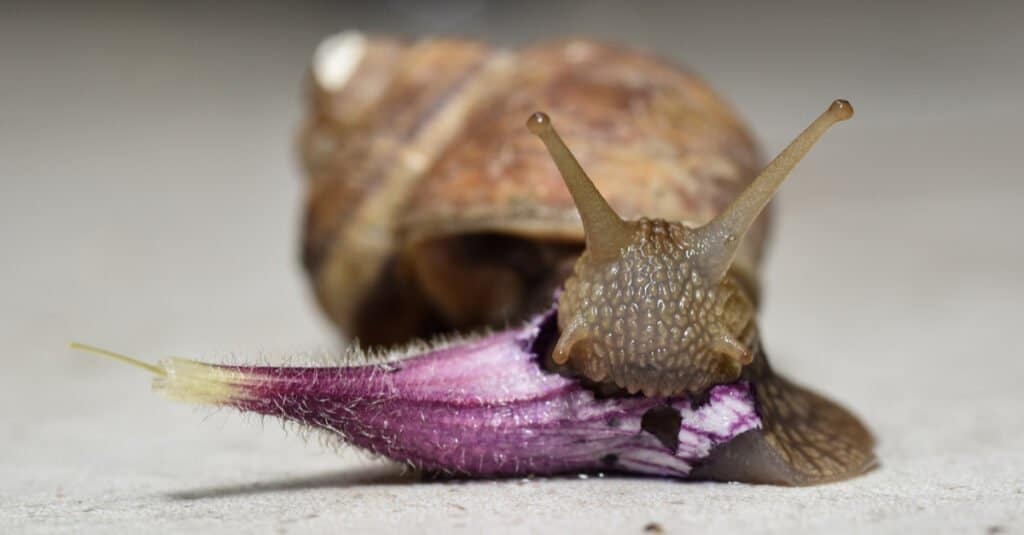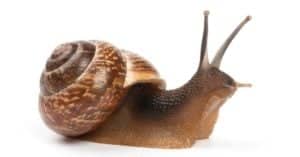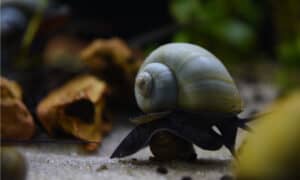Snails. They live all over the world, even in the ocean and in freshwater streams, lakes and marshes. They’re known both for their extreme slowness and for the houses (shells) they carry on their backs. Like all gastropods, they have no internal skeleton or bones. But, unlike slugs, which have no shell, they do have their own exoskeleton in the form of a shell. The shell grows with them, and when they’re in danger, they can suck their bodies completely up into it. But have you ever wondered, just what do snails eat, and what kind of teeth do they have?
Here, we’ll take a deep dive into the anatomy of the snail mouth. We’ll learn about their unique teeth, how many they have, and what they use them for. Then, we’ll take a look at what scientists think may be the hardest substance on earth. Finally, we’ll explore whether or not snails can bite humans, if they’re dangerous, and just how carnivorous snails go about hunting and consuming their prey.
Do Snails Have Teeth?

Snail teeth are located on their radula, which is similar to a tongue.
©Bildagentur Zoonar GmbH/Shutterstock.com
Yes; snails do in fact have teeth. They may not be the kind of teeth you and I have, but they’re there.
First, snails have jaws that they use to pull food into their mouths. But their teeth aren’t located on the jaws–they’re actually located on the radula, the snail’s version of a tongue. The radula is a large, ribbon like structure that can extend far outside the snail’s mouth. For comparison; if humans had radulas, they would be the size of our faces, and we’d be able to extend them fully outside of our mouths. They would be the texture of the coarsest sandpaper you can imagine, and, they’d be unstoppable.
How Many Teeth Do Snails Have?
The radula houses the snail’s ‘teeth’–all 10-25,000 of them. Snails usually have between 10-15,000 teeth, though some may have up to 25,000. They’re generally organized in rows of about 100 teeth per row, and there may be up to 25 rows. Each ‘tooth’ is a small, conical projection on the radula (think of a shag carpet). They’re rounded and conical towards the center of the radula, and thin, sharp, and hooked towards the edges. Working as one, they act as the world’s toughest sandpaper.
What Do Snails Use Their Teeth For?

Snails have between 10-25,000 teeth on their tongue-like radulas
©microcosmos/Shutterstock.com
Snails have extraordinarily varied diets; depending on the species, they can eat everything from plant material, to rotting vegetation and carrion, to live prey like fish and worms. Some snails specialize in things like leaves and algae, and some eat primarily earthworms, while some species, such as marine snails, spend much of their time hunting small fish.
With such a varied diet, it’s no wonder snails have such incredibly efficient teeth. When they eat vegetation, they use their radula to lick it up into their mouth. With thousands upon thousands of toothlike projections, the radula is extremely raspy–like a cat’s tongue, only much more so. The radula is like coarse sandpaper, and the teeth quickly shred anything they come into contact with.
Carnivorous snails also employ their radulas on the creatures they eat, more on that later.
The Hardest Substance in the Natural World?
In the last few years, scientists have made some startling discoveries about the ‘teeth’ of one species of marine snail–the limpet. Limpet teeth are used to break down rock (that’s right–rock) so that the sea-going snail can get to the food it needs. Limpet teeth are made of nanofibers encased in a protein mix, along with an iron containing crystal called goethite.
Together, these things makes the projections (teeth) of the limpet’s radula the hardest known substance on earth, they’re even tougher than spider silk. And when the snail wears its teeth out? It simply replaces them, never running out of teeth or having to resort to gumming its food.
Do Snails Bite Humans?
Snails have particularly rough tongues, and if you place one in your hand, slime to skin, you may just feel the scratch of the radula. Particularly large snails (the giant African land snail can grow up to 15 inches long and is the largest snail in the world) may even give your skin a little pinch. Not to worry though–snail bites aren’t dangerous. But some species do have something to be worried about–venom.
Venomous Snails

Sea snails use harpoon-like proboscis’ to paralyze prey before eating it
©iStock.com/lilithlita
Many species of sea snail are not only carnivorous, they’re venomous. Their mouths come equipped with an appendage called a proboscis. They shoot this proboscis out like a harpoon to spear and envenomate small fish. Their venom paralyzes the fish almost instantly, and the fish becomes helpless to the snail’s consumption.
Using their jaws and radula, they pull the defenseless fish into their mouth. From there the thousands of teeth grind against the prey, breaking it up so the snail can digest it. The teeth act like very rough sandpaper, shredding the fish with nothing more than their touch.
People have to watch out for these venomous snails; their venom is deadly enough to kill a person. So, if you’re walking in the ocean, be sure to wear water-shoes.
Carnivorous Land Snails
It’s not just sea snails that are carnivorous; there are also many species of land snail that feed on insects and even other snails. One species, the Powelliphanta, is native to New Zealand, and eats mostly earthworms
At nightfall, when the Powelliphanta hunts, it first locates its prey by scent. Once close enough, it extends its formidable jaws and lips in one quick movement to grab the worm and pull it into its mouth. From there, the worm is doomed. Using its jaws and the motion of the radula, the snail drags the worm into its mouth like a piece of spaghetti. As the worm is devoured, the teeth on the radula slowly rasp away its body, until it’s ready for digestion.
The photo featured at the top of this post is © microcosmos/Shutterstock.com
Thank you for reading! Have some feedback for us? Contact the AZ Animals editorial team.






